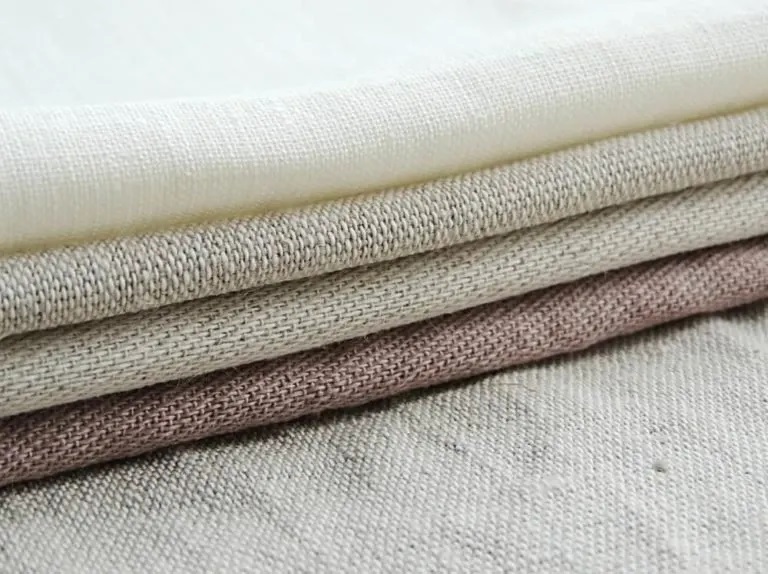Whether you are choosing fabric to sew clothes for your business, casual strolls or going outs, cotton and linen are fibers that will do the trick. Let’s have a look at their properties and see what makes them so suitable for the summer heat.
Cotton: Soft, moisture-absorbing, breathable, from semi-sheer to opaque
Linen: Slubby, softens with each washing, moisture-absorbing, breathable
The Advantages of Cotton Fabrics
Let’s start with cotton fabrics. It’s easy to work with, wash, take care of, and wear if it’s warm or cold. It’s great.
Cotton is one of the most sought-after fabrics when it comes to summer clothing. Available in a wide range of textures and weaves, it can easily construct your basic wardrobe on its own, without any help from other fibers.
Derived from plants, this material is highly absorbent and breathable. It wears beautifully both in dry heat and in humid conditions, and that’s the secret of its popularity all over the world. Why is this fiber perfect for summer needs?
The Pros
Highly absorbent
Breathable
Durable
Easy to wash and care for
Soft
Anti-allergic
Dries fast
Very versatile, cotton is a cool fabric with many options like seersucker, poplin, gauze and madras. Eyelet variety allows more air to come through. Whatever type of cotton fabric by the yard you choose, it will probably need less care than expected, and that’s a great pro.
What Are the Pros and Cons of Linen Fabrics?
Linen fabric is an awesome way to meet the summer heat. Made from the fibers of flax plants, it feels cool and absorbs the sweat, keeping your body all set and comfortable. The best linen is woven in Ireland and Italy. Linen material lacks elasticity and is quite difficult to weave. However, it is easily a number one choice for summer clothing because it is durable, breathable and stronger than cotton.
What makes linen a great option for hot weather?
The Pros
Highly breathable
Absorbs moisture
Durable and strong
Resistant to damage
Easy to wash and care for
Hypoallergenic
Dries fast
Linen has low thread count compared to cotton. Fewer fibers provide unbeatable breathability – just what we expect of a summer fabric. Another reason to love linen cloth is its ability to absorb moisture: linen fibers soak up about one-fifth of their weight in water.
Linen tends to crease easily. However, it tends to wrinkle less with time, as it becomes softer upon washing. Another way to make it resistant to creasing is blend it with cotton. If you have no time for ironing, spray your linen fabric with water and smooth the wrinkles with your hand.
A Guide to Breathable Summer Fabrics
You need to remember several qualities when choosing the right fabric for the summer closet. Have a look at our checklist of characteristics that are inherent to the best summer clothes materials:
Quality
Natural fibers are always better than synthetics. They let your skin breathe, ward off the heat, and feel gentler to the touch. On the contrary, synthetic materials do not have cooling properties.
Weight
The lighter, the better – that’s the rule to stick to. Lighter fabrics tend to be sheer, soft and silky, with a few exceptions having a coarse hand. Heavy cloths even if they are made of natural fibers will make you sweat. Opt for fabrics weighing no more than 250 g/m2.
Breathability
Check the weave of your fabric. The most breathable ones are made with fine threads and in a loose weave.
Color
We all have our own color preferences depending on the skin tone and so on. Still, the scientific fact – lighter colors are champions in beating summer heat because they are better at reflecting light.
Cut
Even the most breathable fabric will lose some of its charms if turned into a bodycon look. Plan for looser cuts and shapes rather than clingy silhouettes. In this case, nothing will hinder air circulation.
How to Care?
If you want summer fabrics to live long and happy, you should take good care of them. What is the recipe for success? Study the recommendations for the type of fabric chosen for the summer wardrobe. Here are some of the basic rules one should follow not to damage the material.
Cotton
1. Cotton is not ok with high temperatures when it comes to washing. 30-40ºC works best for it. Cooler water temperatures prevent shrinkage and colour fading.
2. Do not bleach cotton, otherwise, fibers get weakened and start to rip.
3. Tumble drying is allowed, however, over drying leads to excessive wrinkling.
4. Most cotton fabrics need a little pressing. Use the lower press setting on your iron (around 150ºC). High temperatures can scorch and burn cotton fibers.
Linen
1. Hand or machine washing is better than dry cleaning. Linen becomes softer with each washing and prefers cold or lukewarm water – around 30ºC. Opt for a gentle washing cycle.
2. Do not bleach linen, otherwise, fibers get weakened and start to rip.
3. Tumble drying is not allowed. Instead, hang dry your linen.
4. Iron linen while it is still damp, or with steam (maximum 200ºC). Most linen fabrics look nice without pressing.











